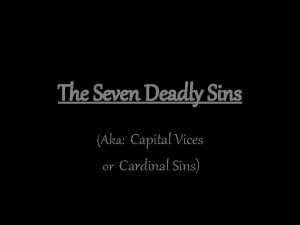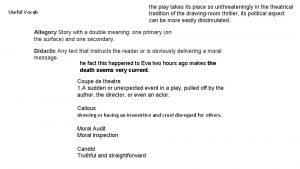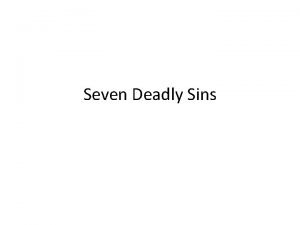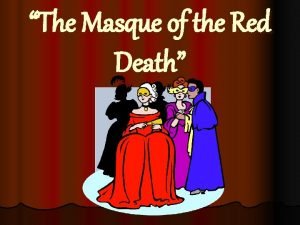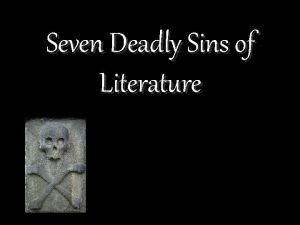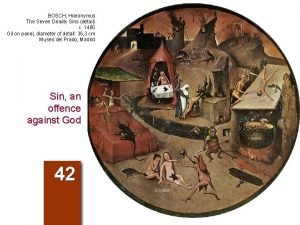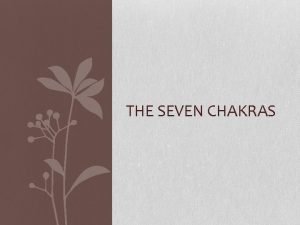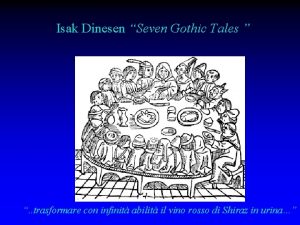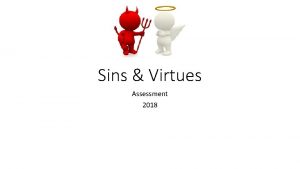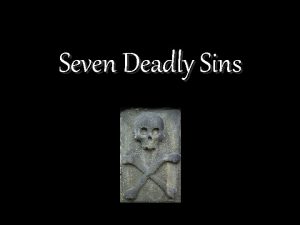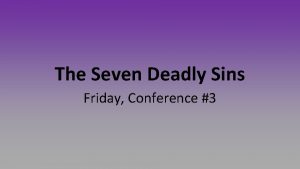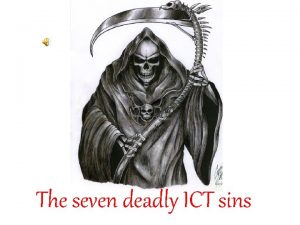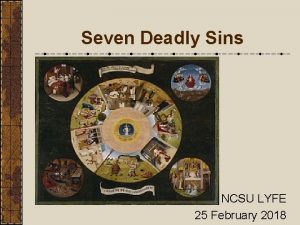The Seven Deadly Sins Aka Capital Vices or













































- Slides: 45

The Seven Deadly Sins (Aka: Capital Vices or Cardinal Sins)

The Seven Deadly Sins is a classification of the most objectionable vices, used since early Christian times to educate and instruct followers concerning immoral fallen man’s tendency to sin. They are Accidia (Sloth), Luxuria (Lust, Lechery), Superbia (Pride), Ira (Wrath, Anger), Invidia (Envy), Avaritia (Greed, Avarice), and Gula (Gluttony)

The book of proverbs states “six things the Lord hateth, and the seventh His soul detesteth”: haughty eyes a lying tongue hands that shed innocent blood a heart that devises wicked plots feet that are swift to run into mischief a deceitful witness that uttereth lies him that soweth discord among brethren.

A 4 th c. monk, Evagrius Ponticus, listed 8 evil thoughts, which are thought to be the modern concept of the Seven Deadly Sins minus sorrow (tristitia). The standard list of seven deadly sins was established by Pope Gregory the Great in the sixth century, in this order: Luxuria (extravagance/lust) Gula (gluttony/excess) Avaritia (avarice/greed) acedia (discouragement/sloth) ira (wrath/anger) invidia (envy) superbia (pride)

The Seven Deadly Sins, by Hieronymus Bosch (1485, oil on panel) is a painted rectangle with a central image of the eye of God, with Christ watching the world. The Seven Deadly Sins, depicted through scenes of worldly transgression, are arranged around the circular shape. The circular layout with god in the center represents god’s all seeing eye. In the corners of the image appear the "Four Last Things" mentioned in late medieval spiritual handbooks: Deathbed, the Last Judgment, Heaven, and Hell, all of which are favorite themes of separate Bosch panels.


Traditional punishment for committing the sins: • Pride=Broken on the wheel • Envy=Encased in freezing water • Avarice (Greed)=Boiled in oil • Wrath (Anger)=Torn apart, limb from limb • Lust=Roasted by fire and brimstone • Gluttony=Forced to eat rats, snakes, spiders, and toads • Sloth (Apathy)=Thrown into snake pits


Seven Deadly Sins or the Seven Vices, Lechery, Pieter Brueghel the Elder, engraving, 16 th c.

Seven Deadly Sins, Rafael, engraving,

Gluttony, Paul Cadmus, 1949, tempera on cardboard

Anger

Avarice/Greed

Envy

Pride

Sloth

Student Examples







Sloth





















The End
 7 deadly sins vs 7 heavenly virtues
7 deadly sins vs 7 heavenly virtues The seven vices
The seven vices Seven deadly sins lust definition
Seven deadly sins lust definition Act 4 dr faustus
Act 4 dr faustus Miracle play examples
Miracle play examples Clothes mean something quite different to a woman
Clothes mean something quite different to a woman 7 deadly sins georgia
7 deadly sins georgia 7 deadly sins and spongebob
7 deadly sins and spongebob Masque of the red death symbolism chart
Masque of the red death symbolism chart Gawain seven deadly sins
Gawain seven deadly sins Seven deadly sins in literature
Seven deadly sins in literature The seven deadly sins bosch
The seven deadly sins bosch Virtues and vices are attitudes. what are their objects?
Virtues and vices are attitudes. what are their objects? The 11 deadly sins of search engine optimization
The 11 deadly sins of search engine optimization 4degreez 7 deadly sins
4degreez 7 deadly sins 7 deadly sins chakras
7 deadly sins chakras 7 deadly sins of communication ted talk
7 deadly sins of communication ted talk Feigenbaum 4 deadly sins
Feigenbaum 4 deadly sins Rene grinzo glomerulonefritico
Rene grinzo glomerulonefritico Gurus of tqm
Gurus of tqm Seven sins mc sundsvall
Seven sins mc sundsvall Seven grave sins
Seven grave sins Seven sins against the holy spirit
Seven sins against the holy spirit Blasphemy dove
Blasphemy dove Seven hill mont
Seven hill mont Capital allocation line vs capital market line
Capital allocation line vs capital market line Multinational capital structure
Multinational capital structure Regulatory capital vs economic capital
Regulatory capital vs economic capital Difference between capital reserve and reserve capital
Difference between capital reserve and reserve capital Constant and variable capital
Constant and variable capital Net working capital refers to which of the following
Net working capital refers to which of the following Basle ii
Basle ii Multinational cost of capital and capital structure
Multinational cost of capital and capital structure Source of capital reserve
Source of capital reserve Chúa yêu trần thế alleluia
Chúa yêu trần thế alleluia Khi nào hổ mẹ dạy hổ con săn mồi
Khi nào hổ mẹ dạy hổ con săn mồi Diễn thế sinh thái là
Diễn thế sinh thái là Vẽ hình chiếu vuông góc của vật thể sau
Vẽ hình chiếu vuông góc của vật thể sau Công thức tính thế năng
Công thức tính thế năng 101012 bằng
101012 bằng Tỉ lệ cơ thể trẻ em
Tỉ lệ cơ thể trẻ em Lời thề hippocrates
Lời thề hippocrates Vẽ hình chiếu đứng bằng cạnh của vật thể
Vẽ hình chiếu đứng bằng cạnh của vật thể đại từ thay thế
đại từ thay thế Quá trình desamine hóa có thể tạo ra
Quá trình desamine hóa có thể tạo ra Môn thể thao bắt đầu bằng chữ f
Môn thể thao bắt đầu bằng chữ f

